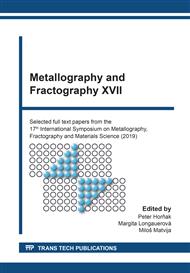p.3
p.11
p.19
p.26
p.33
p.43
p.48
p.54
Novel Cost-Efficient Method of Producing Ausferritic Steels Displaying Excellent Combination of Mechanical Properties
Abstract:
Round bars Ø 53 mm were hot-rolled from a 1.4 tonne ingot forged to 165 × 165 mm. The composition of the steel was 0.45 wt. % C and 3.33 wt. % Si plus alloying elements for hardenability. Microstructure after air cooling from 1010 °C on the cooling bed was predominantly ausferritic. Tensile testing of as-rolled bars resulted in yield strength 846 ± 22 MPa, ultimate tensile strength 1169 ± 99 MPa and A5-elongation of 1.7 ± 0.8 % (without prior necking). When as-rolled steel was baked in air at T = {Ms initial -30 K} for six hours, the yield stress raised to 1121 ± 4 MPa, the ultimate tensile stress raised to 1447 ± 5 MPa and the elongation raised to 22.6 ± 1.6 % (with necking > 18 %). For as-rolled bars during continuous cooling, the exposure time within the temperature range 460 – 320 °C was estimated to be about 10 minutes. The microstructure of as-rolled “semi-finished” bars is stable at room temperature. The first baking was done six months after hot-rolling. Optical and scanning electron microscopy showed that remaining areas of austenite, not transformed during continuous cooling but stable at room temperature, transforms to ausferrite when properly baked.
Info:
Periodical:
Pages:
11-18
Citation:
Online since:
November 2020
Authors:
Keywords:
Price:
Сopyright:
© 2020 Trans Tech Publications Ltd. All Rights Reserved
Share:
Citation:


